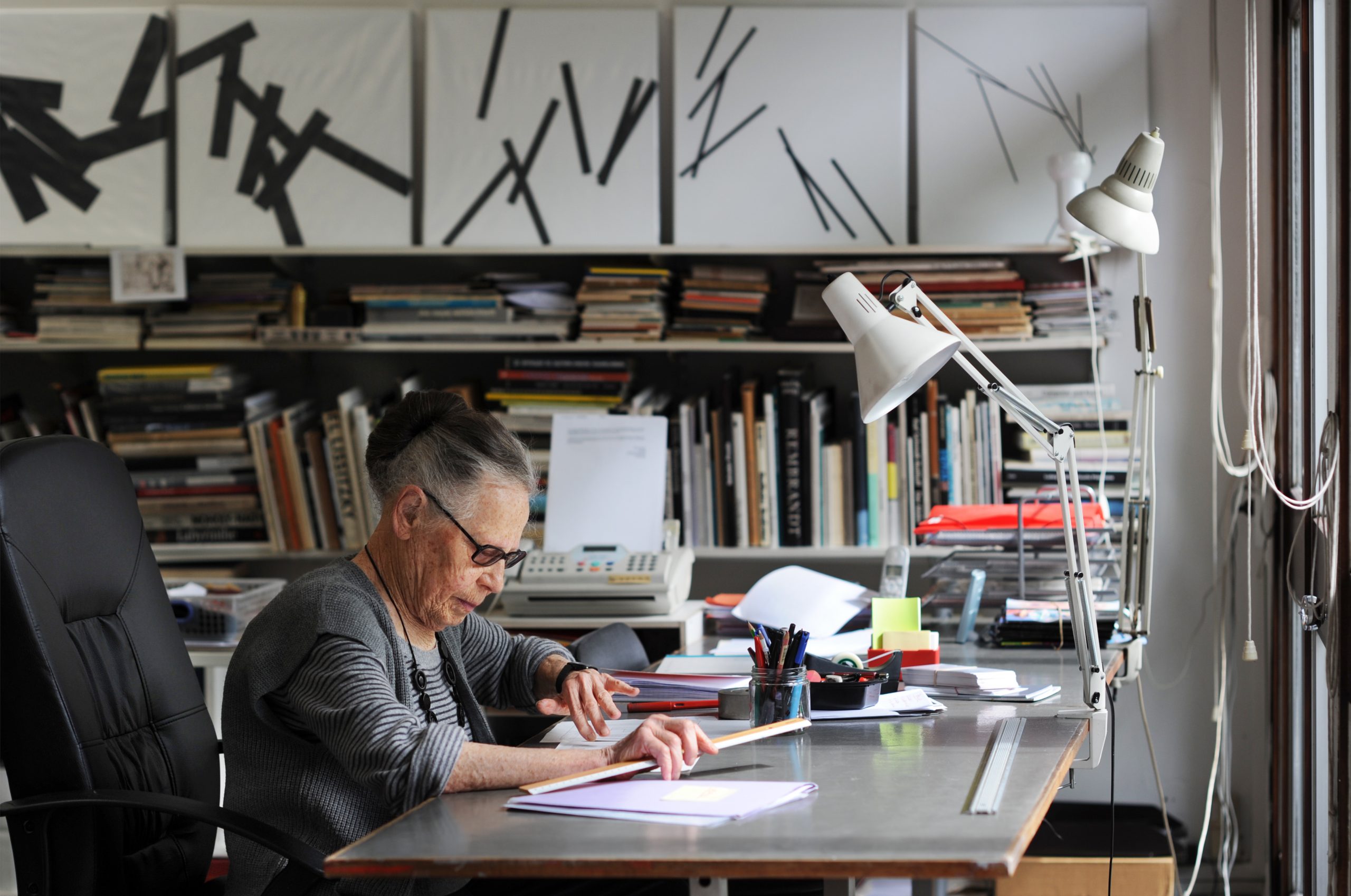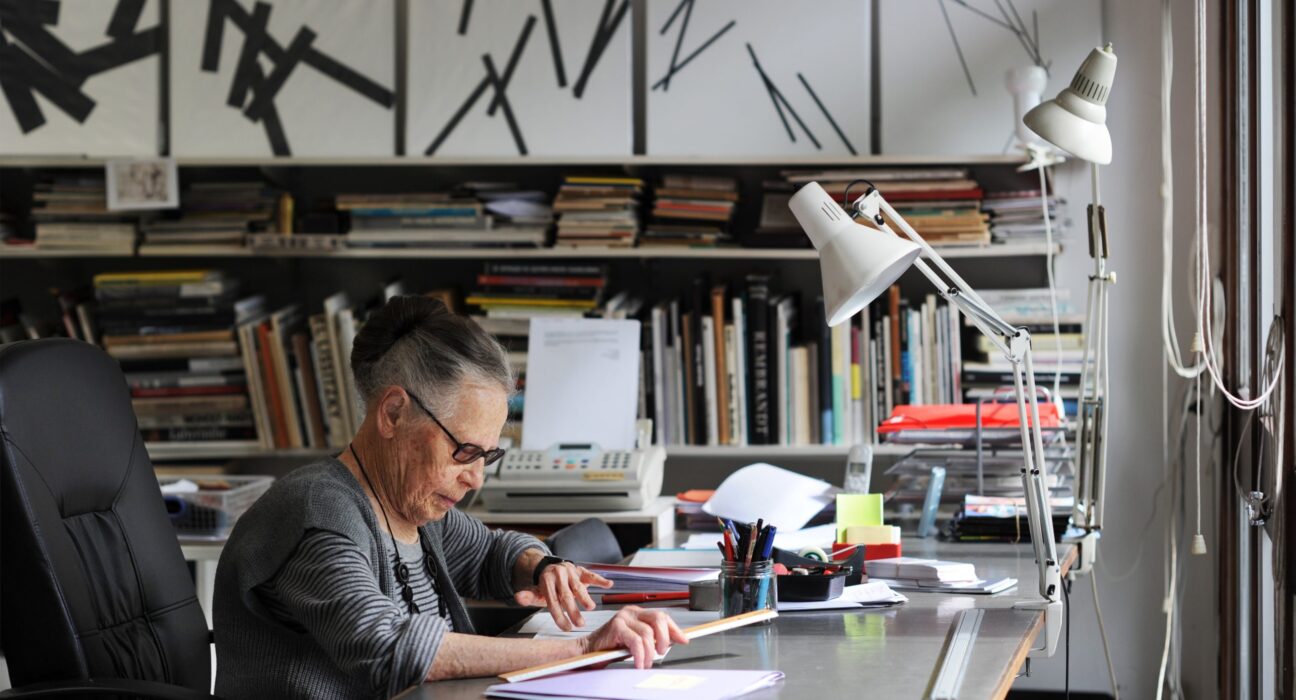
Vera Molnár, the media artist who pioneered generative art-making, has died at age 99. Her passing was announced on December 7 by Centre Pompidou, which is due to host an exhibition of Molnár’s work in 2024.
“It is with deep emotion that we learn of the passing of Vera Molnár with whom we had worked passionately for her next major exhibition at the Center Pompidou,” the museum wrote on X.
Digital artists and platforms including Dmitri Cherniak, Mario Klingemann, ARSNL Art, and Art Blocks likewise commiserated about Molnár’s passing—paying tribute to an artist whose groundbreaking computational artworks, which she began in the 1950s, heralded the algorithmic art of today.
“The machine, thought to be cold and inhuman, can help to realize what is most subjective, unattainable, and profound in a human being,” she once noted.
Notebooks by Vera Molnár at her home and studio workshop on April 5, 2017 in Paris, France. Photo: Catherine Panchout/ Sygma via Getty Images.
Born in 1924 in Budapest, Hungary, Molnár was trained in aesthetics and art history at the Hungarian University of Fine Arts. Her interest in art, however, would brush up against her fascination with numbers and geometry in ways that extended far beyond traditional bounds.
In the late 1950s, following a move to Paris, Molnár commenced a systematic approach to her work, a sequential process she called “machine imaginaire.” It involved mapping out a series of steps, much like computerized inputs and outputs, which would determine an artwork’s final form. In other words, she had devised for herself a programming language, a foundation for generative art to come.
With her process, Molnár would produce highly geometric, hand-drawn works, such as those in her “Slow Movement” series. These pieces would grow increasingly intricate as she availed herself of tools such as plotters and early computers. By the 1970s, she was turning out complex drawings such as her celebrated À la recherche de Paul Klee (1970), an ink-plotter riff on Klee’s Cubism, and Structures of Squares (1974), created with a randomized framework using the RESEAU-TO program.
Vera Molnár, À la recherche de Paul Klee (1970). Photo: © Vera Molnár, © Museum Associates/LACMA.
Molnár’s work was intertwined with artist-led research groups that she spearheaded to explore how creatives could better collaborate with machines. In particular, the Groupe de Recherche d’Art Visuel, which included artists such as Julio Le Parc, Francisco Sobrino, and Horacio Garcia Rossi, presented its Labyrinth installation at the Paris Biennale in 1963, where visitors were invited to engage with various optical and kinetic objects.
The arrival of personal computers in the ’80s marked a shift for Molnár: “It changed everything,” she remembered in 2022. They allowed her to work from home, for one, where she continued to produce works such as Hommage à Dürer (1989–2004), recursive variations of which she created with plotters and embroidery.
Vera Molnar (Des)ordres (1974). Courtesy Phillips
The new millennium brought Molnár new recognition. She was bestowed the DAM Digital Arts Award in 2005, then appointed Chevalier of Arts and Letters by the French cultural ministry in 2007. Molnár’s work was also included in a smattering of exhibitions: at the Museum of Modern Art in 2010 and 2017, the Museum Haus Konstruktiv in 2015, and Senior & Shopmaker Gallery in 2018.
Then, the generative art scene blew up. That the generative or algorithm art of today owes a debt to early computer artists including Molnár, Frieder Nake, and Frederick Hammersley has not gone unnoticed or unrecognized.
As she spent her later days in a Paris nursing home, Molnár has watched her pioneering work being newly embraced. Most prominently, they were included in the 2022 Venice Biennale, which featured a gallery devoted to her 1970s and ’80s works.
A test mint from Vera Molnar’s “Themes and Variations.” Photo courtesy Sotheby’s.
One of her last acts was “Themes and Variations,” a generative art series she created in collaboration with Art Blocks and digital artist Martin Grasser, which produced 500 unique, typographic NFTs. The project kicked off Sotheby’s Gen Art Program in June 2023 and raked in $1.2 million.
“It’s an amazing thing, to wake up in the morning… to start scribbling without having any idea what it is you’re after. You try the same thing with a computer, and what you were dreaming of starts slowly to unfold,” she said in 2022. “This is what’s paradoxical about the computer—it helps you to bring into the world what you had only imagined, even when you yourself don’t know what that is.”
More Trending Stories:
Inspector Schachter Uncovers Allegations Regarding the Latest Art World Scandal—And It’s a Doozy
Archaeologists Call Foul on the Purported Discovery of a 27,000-Year-Old Pyramid
A Polish Grandma Found a Rare Prehistoric Artifact—And Kept It Quiet for 50 Years
Art Critic Jerry Saltz Gets Into an Online Skirmish With A.I. Superstar Refik Anadol
Your Go-To Guide to All the Fairs You Can’t Miss During Miami Art Week 2023
The Old Masters of Comedy: See the Hidden Jokes in 5 Dutch Artworks
David Hockney Lights Up London’s Battersea Power Station With Animated Christmas Trees
Follow Artnet News on Facebook:
Want to stay ahead of the art world? Subscribe to our newsletter to get the breaking news, eye-opening interviews, and incisive critical takes that drive the conversation forward.

